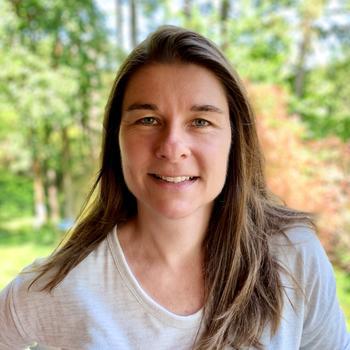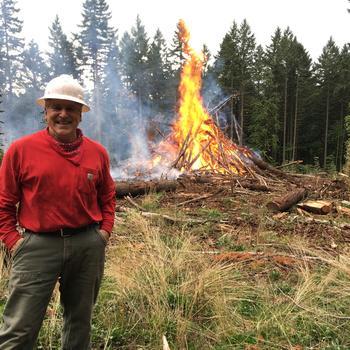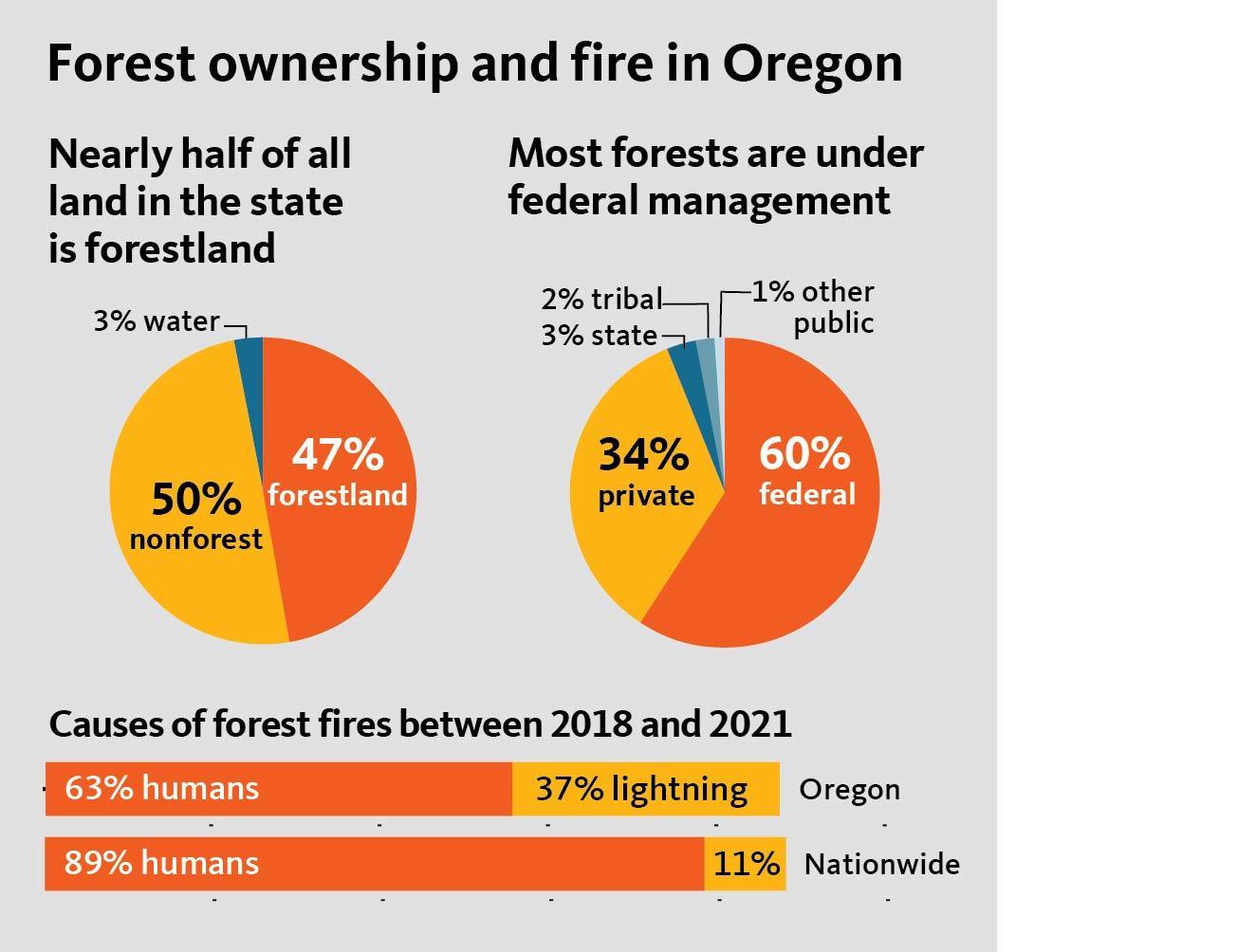With forests making up nearly half of all land in Oregon, these landscape conditions set the stage for frequent occurrences of wildfires across the state. But a comprehensive picture of the wildfire landscape is complicated by the mix of public and private ownerships that control just under 30 million acres together.
Fire frequency and size
Is the number of wildfires increasing?
Research shows that wildfire season lasts longer and is more active than it was a few decades ago. The duration of fire season influences the window of opportunity for natural and human-caused wildfires, and the number of fires varies by land ownership. In the last 15 years (2007–2021) in Oregon, the total number of individual wildfires on public, state, and private lands has slightly increased. Generally, the number of wildfires on federal public lands is greater than on state or private lands. That’s because the federal government manages just under 18 million forested acres, or 60% of the forestland in Oregon. With more contiguous public land, there is more potential for fire on those acres. Nationally, the reverse is true—the number of wildfires on private lands is greater than on federal lands because more lands are privately owned nationally.
What are the causes of wildfires?
People are the leading cause of wildfires, both in Oregon and across the nation. The probability of a wildfire increases as more people live, visit, recreate and work in a given area. On private lands, the leading causes of wildfires are debris burning, machine use and accidental ignitions due to recreational campfires. While fires caused by people are the most common, they tend to burn fewer acres because of their proximity to urbanized areas and easy access for first responders.
Lightning is another major cause of fires. Federal lands make up much of Oregon’s “lightning belt” or “lightning alley” — a diagonal strip of the state from southwestern to northeastern Oregon where lightning strikes are more common, especially during the hot and dry months of July and August. These fires are usually hard to suppress in a timely manner because of steep terrain and limited access. This adds to the increased acreage burned on federal lands.
Is the size of wildfires increasing?
Fire has consumed an increasing amount of acreage across all lands in Oregon over the last 15 years. In fact, the 2020 wildfire season, which burned over 1million acres, was one of the worst on record for Oregon and the nation regarding total acres burned.
Some possible reasons for the increase in total acreage burned over the last 15 years include:
- An increase in the number of homes built in forested areas.
- A history of fire suppression that has led to an increase in the amount of fuels that are contiguous across the landscape.
- A warmer and drier climate that is causing available dead fuels to dry out earlier in the year.
- A warmer and drier climate that reduces the moisture content of live vegetation. This increases plants’ potential to combust, adding to the available fuels across the landscape.
- Erratic weather and climatic patterns, including more extreme wind and drought events.
Differences in firefighting strategies between ownerships may also affect the total number of acres burned. The priority for each wildland fire management activity by all local, state and federal agencies is firefighter and public safety. The Oregon Department of Forestry actively suppresses fires on its own lands, on assessed private lands and by contract on western Oregon Bureau of Land Management lands.
The U.S. Forest Service also actively suppresses wildfires and uses backburning and burnouts to stop fires, increasing the area of acreage burned. The USFS also recognizes the natural role of fire on the landscape and, under strict conditions, allows the fires to burn without full suppression to benefit resources. (This is another factor that increases the number of acres burned.)
Many large fires aren’t necessarily bad, except when the impacts are severe and involve homes and other human infrastructure. Fires have occurred across Oregon’s landscapes since time immemorial. Native Peoples utilized fire to replenish and restore the land. Fire is part of Oregon’s natural systems, and some forest types (and wildlife) even need fire to thrive. Oregon needs more prescribed fire, not catastrophic wildfires, to reduce fuel across the landscape and improve forest health.
Land ownership and fire
Does it matter who owns the forest when it comes to fire? Not necessarily, because fire knows no boundaries. In addition, no two forests are alike, nor are they managed the same way. Typically, federal, state, and non-industrial and industrial private lands are managed for different objectives. Topography and weather aside, different management strategies affect the amount and arrangement of fuels. Those differences influence fire behavior (including fire intensity) and the number of acres burned.
Forest management that considers fire risk and applies the appropriate management strategies may reduce the area burned by unwanted fires and the intensity and severity at which they burn.
Resources
Balch, J., B.A. Bradley, J.T. Abatzoglou, R.C. Nagy, E.J. Fusco, and A.L. Mahood. 2017. Human-started wildfires expand the fire niche across the United States. Proceedings of the National Academy of Sciences of the US, 114 (11) 2946-2951: https://doi.org/10.1073/pnas.1617394114
Bennett, M., S. Fitzgerald, D. Leavell, and C. Berger. 2018. Fire FAQs: Have the size and severity of forest wildfires increased in Oregon and across the West? Oregon State University Extension Service (EM 9194), https://catalog.extension.oregonstate.edu/em9194
Berger, C., S. Fitzgerald, and D. Leavell. 2018. Fire FAQs: Managing Wildfire for Resource Benefit: What is it and is it beneficial? Oregon State University Extension Service (EM 9193), https://catalog.extension.oregonstate.edu/em9193
Gabbert, G. 2018. Nearly a record-breaking year for acres burned in the U.S. Wildfire Today, http://wildfiretoday.com/2018/01/10/nearly-a-record-breaking-year-for-acres-burned-in-the-u-s/. Accessed August 1, 2018
Keep Oregon Green. https://keeporegongreen.org/. Accessed January 19, 2023
Leavell, D., C. Berger, S. Fitzgerald, B. Parker. 2017. Fire Science Core Curriculum, Module 3—Fire Behavior, Oregon State University Extension Service, (EM 9172), https://catalog.extension.oregonstate.edu/em9172module3
National Interagency Fire Center. https://www.nifc.gov/fireInfo/fireInfo_statistics.html. Accessed January 19, 2023
Oregon Department of Forestry. Oregon Forests: Some Facts and Figures, September 2009
Oregon Forest Resources Institute. https://oregonforests.org/content/forest-ownership-interactive-map. Accessed January 19, 2023
Oregon State University Forestry & Natural Resources Extension fire program, http://extensionweb.forestry.oregonstate.edu/fireprogram
Reilly, M. J., C.J. Dunn, G.W. Meigs, T.A. Spies, R.E. Kennedy, J.D. Bailey, and K. Briggs. 2017. Contemporary patterns of fire extent and severity in forests of the Pacific Northwest, USA (1985–2010). Ecosphere, 8(3): e01695. 10.1002/ecs2.1695
Stein, S.M., J. Menakis, M.A. Carr, S.J. Comas, S.I. Stewart, H. Cleveland, L. Bramwell, and V.C. Radeloff. 2013. Wildfire, wildlands, and people: understanding and preparing for wildfire in the wildland-urban interface—a Forests on the Edge report. Gen. Tech. Rep. RMRS-GTR-299. Fort Collins, CO. US Department of Agriculture, Forest Service, Rocky Mountain Research Station.
© 2023 Oregon State University.
Extension work is a cooperative program of Oregon State University, the U.S. Department of Agriculture, and Oregon counties. Oregon State University Extension Service offers educational programs, activities, and materials without discrimination on the basis of race, color, national origin, religion, sex, gender identity (including gender expression), sexual orientation, disability, age, marital status, familial/parental status, income derived from a public assistance program, political beliefs, genetic information, veteran’s status, reprisal or retaliation for prior civil rights activity. (Not all prohibited bases apply to all programs.) Oregon State University Extension Service is an AA/EOE/Veterans/Disabled.




